Photorejuvenation Devices Market Research, 2031
The global photorejuvenation devices market size was valued at $587.4 million in 2021 and is projected to reach $1,543.5 million by 2031, growing at a CAGR of 10.4% from 2022 to 2031. Photorejuvenation is a broad category that includes a variety of non-invasive cosmetic procedures that use the natural energy from light to improve the condition of the skin. This procedure helps tackle redness and brown spots on the face and is also called a photo facial, or intense pulsed light (IPL) procedure, it is a non-invasive procedure that makes the face look more youthful by removing sun damage, and signs of rosacea, and reducing pores or acne spots.
It is highly recommended for those who have various skin problems, such as rosacea, stretch marks, hyperpigmentation or brown spots, or the darkening of the skin due to the overproduction of skin pigment called melatonin, wrinkles, spider veins, which are caused by dilated capillaries, melasma, or blotchy, gray or brown patches on the face (also known as chloasma), freckles, age, and sunspots and visible or broken capillaries.
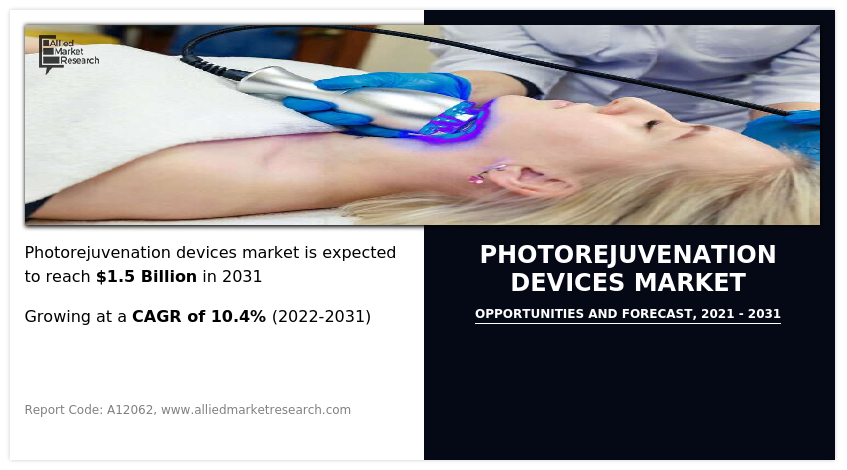
Historical overview
The market was analyzed qualitatively and quantitatively from 2018 to 2020. Most of the growth during this period was derived from the Asia-Pacific owing to a rise in the prevalence of skin disorders, the surge in the geriatric population, an increase in health awareness, a rise in disposable incomes, as well as the well-established presence of key pharmaceutical device manufacturers in the region.
Market dynamics
The growing prevalence of skin disorders has been leading to scarring is the major factor propelling the growth of the market. For instance, according to the Institute of Health Metrics and Evaluation, skin diseases contributed to 4.86 billion incident cases around the world in 2019. Moreover, age is a factor in the prevalence of skin disorders. As one gets older, the risk of acquiring a skin disorder increase, due to the changes in connective tissue, reduction in the skin’s strength and elasticity, as well as the reduction in secretions from sebaceous glands. According to a report published by the Asia Development Bank it has been estimated that Asia-Pacific’s elderly population is projected to reach 923 million by 2050. The rise in awareness towards the adoption of non-invasive photorejuvenation equipment owing to benefits offered such as lesser side effects has also led to an increase in demand for technologically advanced photorejuvenation devices that propels the growth of the market. The demand for skin rejuvenation devices is not only limited to developed countries but is also being witnessed in developing countries, owing to the rapid increase in geriatric populations and environmental factors such as UV exposure, pollution, humidity, and excessive heat and cold that impact the skin and leads to the development of chronic skin ailments such as acne, freckles, birthmarks, hyperpigmentation, rosacea, scars and various in countries like China, Brazil, and India, fuel the growth of the market.
The outbreak of COVID-19 has disrupted workflows in the healthcare sector around the world. The disease has forced several industries to shut their doors temporarily, including several sub-domains of health care. The global photorejuvenation device market experienced a decrease in 2020 as the pandemic significantly impacted the supply chain. The market for global photorejuvenation devices has shown declining results in the growth rate owing to a decline in the number of cosmetic procedures due to the pandemic. For instance, in March 2020, the North American medical regulatory agencies and organizations, including the American Academy of Facial Plastic and Reconstructive Surgery, issued recommendations to cease all non-essential and elective services at public or corporate healthcare facilities. The rising cost of supply chain and logistics has had an adverse effect on the company’s finances and liquidity. However, the market is anticipated to witness steady growth in 2021 and is anticipated to grow at a significant CAGR during the forecast period for the photorejuvenation device market. This is attributed to the increase in the prevalence of skin disorders. Moreover, the growing awareness among the population about non-invasive surgical procedures with reduced side effects as compared with other surgical surgeries is increasing the adoption of non-invasive photorejuvenation devices. In addition, social distancing had led people to spend long hours on video calls, which promoted appearance dissatisfaction, and the evolution of dysmorphic thoughts about the body, especially the face, which has resulted in increased demand for esthetic and cosmetic procedures that propels the growth of the market.
Segmental Overview
The photorejuvenation device market is segmented on the basis of product, modality, end-user, and region. By product, the market is segmented into intense pulsed light, laser equipment, and LED equipment. By modality, it is divided into standalone and portable. By end user, it is classified into, hospitals, dermatology clinics, and others. Region-wise, it is analyzed across North America, Europe, Asia-Pacific, and LAMEA.
By Type
Based on type, the market is segmented into intense pulsed light, laser equipment, and LED equipment. The laser equipment segment dominated the global market in 2021 and is expected to remain dominant throughout the forecast period, owing to a rise in the demand for laser-based equipment for aesthetic procedures.
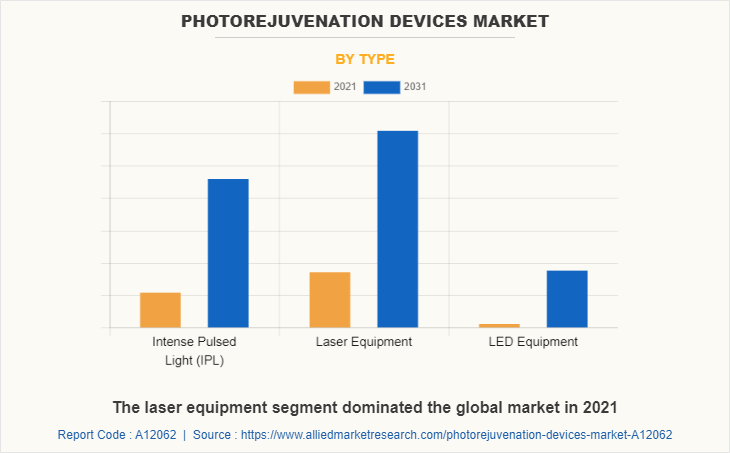
By Modality
Photorejuvenation Devices Market share is bifurcated into standalone and portable. The standalone segment dominated the global market in 2021 and is anticipated to continue this trend during the forecast period. This is attributed to the advantages offered by standalone photorejuvenation devices such as standalone laser devices that have a single wavelength and a small variety of applicators.
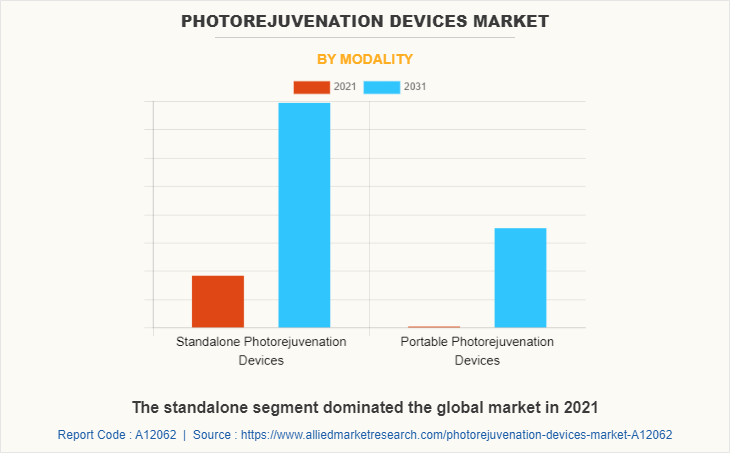
By End User
The Photorejuvenation Devices Market Size is segmented into hospitals, dermatology clinics, and others. The hospital segment dominated the global market in 2021 and is anticipated to continue this trend during the forecast period. This is attributed to the rise in the prevalence of skin disorders and the increase in demand for photorejuvenation treatment that is best suited for patients with chronic sun damage, and rosacea.
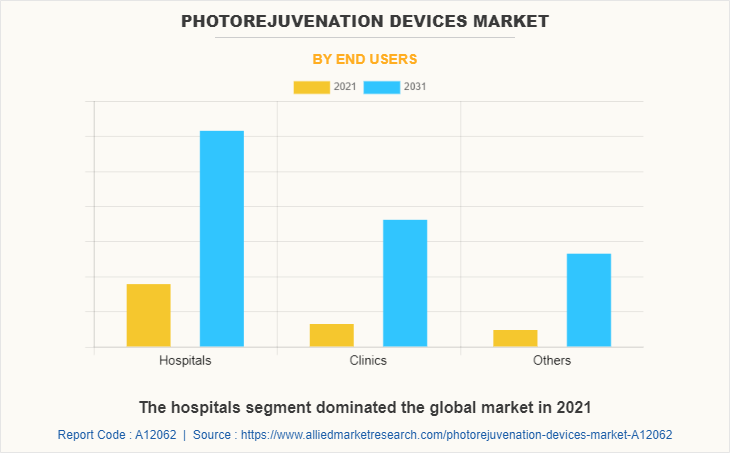
By Region
The photorejuvenation device market share is analyzed across North America, Europe, Asia-Pacific, and LAMEA. North America accounted for a major share of the Photorejuvenation Device market in 2021 and is expected to maintain its dominance during the forecast period. The presence of several major players and the advancement in the technology of photorejuvenation devices in the region drive the growth of the market. The photorejuvenation device market is mainly driven by the presence of well-established healthcare facilities for medical devices, a growing geriatric population, and the rising prevalence of skin disorders. Furthermore, increasing awareness among the population towards the use of aesthetic products, and the rise in technological advancements to provide a diverse treatment option for aesthetic or cosmetic purposes is expected to fuel the market growth. Furthermore, increasing investment by pharmaceutical companies in R&D activities to design technologically advanced medical devices through innovative research is expected to fuel the market growth in this region.
Asia-Pacific is expected to grow at the highest rate during the forecast period. The Photorejuvenation Devices Market growth in this region is attributable to the presence of pharmaceutical medical device manufacturers in the region as well as the rise in the geriatric population of the countries, such as China and India. Asia-Pacific is expected to register the fastest CAGR during the forecast period. Owing to the leading consumer of photorejuvenation devices, due to the presence of a large population. China and India are key markets in the region. The rise in incidences of skin diseases, improvement in the healthcare infrastructure and economic growth of China, India, and others countries of Southeast Asia are resulting in high per capita healthcare expenditure are the factors set to drive the market growth in the Asia-Pacific region. Furthermore, the Asia-Pacific region exhibits the largest supply of medical devices and the largest pharmaceutical industry with the availability of technologically advanced medical devices in abundance, which can be easily accessed by consumers. This, in turn, drives the growth of the market. Asia-Pacific offers profitable opportunities for key players operating in the photorejuvenation device market, thereby registering the fastest growth rate during the Photorejuvenation Devices Market forecast period, owing to the growing infrastructure of industries, rising disposable incomes, as well as the well-established presence of domestic companies in the region. In addition, increased technological innovations and heavy funding by government and private organizations, and increased investment by companies in R&D activities are expected to provide great opportunities for the growth of the market in this region.
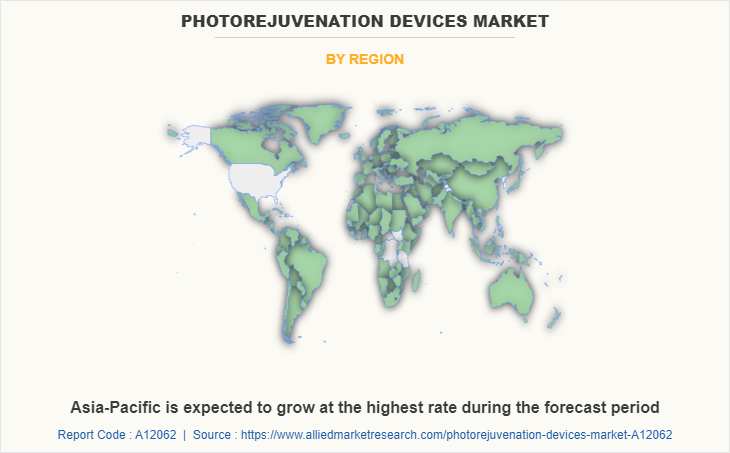
COMPETITION ANALYSIS
Competitive analysis and profiles of the major players in the photorejuvenation device market, such as Hologic, Lumenis, Candela Corporation, Lynton Lasers Ltd., Cutera, Lutronic Inc, Nubway, Fotona, Biolitec AG, and Deka Laser are provided in this report.
Some examples of product launches in the market
Lumenis Ltd. announced the launch of its newest, innovative platform, the Stellar M22. This launch help Lumenis’ to improve the standard of care in the skincare market. The new Stellar M22 IPL allows for easy and quick treatment with great output and efficacy.
Key Benefits For Stakeholders
- This report provides a quantitative analysis of the market segments, current photorejuvenation devices market trends, estimations, and dynamics of the photorejuvenation devices market analysis from 2021 to 2031 to identify the prevailing photorejuvenation devices market opportunity.
- Market research is offered along with information related to key drivers, restraints, and opportunities.
- Porter's five forces analysis highlights the potency of buyers and suppliers to enable stakeholders to make profit-oriented business decisions and strengthen their supplier-buyer network.
- An in-depth analysis of the photorejuvenation devices industry segmentation assists to determine the prevailing market opportunities.
- Major countries in each region are mapped according to their revenue contribution to the global market.
- Market player positioning facilitates benchmarking and provides a clear understanding of the present position of the market players.
- The report includes an analysis of the regional as well as global photorejuvenation equipment market trends, key players, market segments, application areas, and market growth strategies.
Photorejuvenation Devices Market Report Highlights
| Aspects | Details |
| Market Size By 2031 | USD 1.5 billion |
| Growth Rate | CAGR of 10.4% |
| Forecast period | 2021 - 2031 |
| Report Pages | 359 |
| By End Users |
|
| By Type |
|
| By Modality |
|
| By Region |
|
| Key Market Players | Deka Laser, Biolitec AG, Hologic, Inc., lutronic, Cutera, candela corporation, Beijing Nubway S&T Co.,Ltd, Lumenis, Lynton Laser, Fotona |
Analyst Review
According to several interviews conducted, the photorejuvenation device market is expected to witness significant growth in the future, owing to an increase in the preference for non-invasive surgery, a rise in the number of skin-related disorders, increased deployment of combination therapy lasers for tattoos and hair removal, and a rise in the number of geriatric populations.
According to the perspectives of CXOs, the photorejuvenation device market is expected to witness steady growth in the future. The increase in the prevalence of skin cancer among the population fosters the rise in demand for better and more advanced technologies such as intense pulsed light, LED equipment, laser equipment, and others. This is anticipated to fuel market growth. The surge in awareness about maintaining good skin health amongst the population, rise in healthcare expenditure, and increase in adoption of advanced photorejuvenation products owing to an increase in skin-related disorders such as acne, alopecia, atopic dermatitis, sunburn, rosacea, and various others, or old age, are the key factors driving the growth of the market. However, high risks associated with photorejuvenation devices, hamper the growth of the market up to some extent during the forecast period.
As per CXOs, North America is expected to dominate the global photorejuvenation device market during the forecast period, followed by Europe. In addition, emerging economies such as India, China, Mexico, and Brazil are expected to offer lucrative opportunities owing to environmental factors such as UV exposure, pollution, humidity, and excessive heat and cold that impact the skin and lead to chronic skin ailments such as acne, freckles, birthmarks, hyperpigmentation, rosacea, scars and various other which require photorejuvenation device for better skin care treatment.
The rise in awareness towards the adoption of non-invasive photorejuvenation equipment owing to benefits offered is one of the major trends in Photorejuvenation Devices Market
The standalone segment dominated the global market in 2021 and is anticipated to continue this trend during the forecast period.
North America accounted for a major share of the Photorejuvenation Device market in 2021 and is expected to maintain its dominance during the forecast period.
The global photorejuvenation device market was valued at $587.4 million in 2021 and is projected to reach $1,543.5 million by 2031, registering a CAGR of 10.4% from 2022 to 2031.
Lumenis Be Ltd., Candela Corporation, Cutera and Fotona are few major players operating in the Photorejuvenation Devices Market.
High cost of photorejuvination and few sie effects associated with the treatment method might restrict the market growth.
Rise in skin-related disorders coupled with the increase in medical technologies will drive the growth of the market.
Yes, the competitive landscape is included in the Photorejuvenation Devices Market report
Loading Table Of Content...


